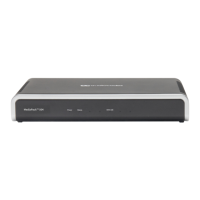Version 6.2 453 February 2011
SIP User's Manual 10. Configuration Parameters Reference
Parameter Description
EMS: NTT DID Signalling
Form
[NTTDIDSignallingForm]
Determines the type of DID signaling support for NTT (Japan) modem:
DTMF- or Frequency Shift Keying (FSK)-based signaling. The devices
can be connected to Japan's NTT PBX using 'Modem' DID lines. These
DID lines are used to deliver a called number to the PBX.
[0] = FSK-based signaling (default)
[1] = DTMF-based signaling
Note: This parameter is applicable only to FXS interfaces.
EMS: Enable DID
[EnableDID]
This ini file table parameter enables support for Japan NTT 'Modem' DID.
FXS interfaces can be connected to Japan's NTT PBX using 'Modem'
DID lines. These DID lines are used to deliver a called number to the
PBX. The DID signal can be sent alone or combined with an NTT Caller
ID signal.
The format of this parameter is as follows:
[EnableDID]
FORMAT EnableDID_Index = EnableDID_IsEnable;
[\EnableDID]
Where,
Index = Port number (where 0 denotes Port 1).
IsEnable = Enables [1] or disables [0] (default) Japan NTT Modem
DID support.
For example:
EnableDID 0 = 1; (DID is enabled on Port 1)
Notes:
This parameter is applicable only to FXS interfaces.
For an explanation on using ini file table parameters, see ''Configuring
ini File Table Parameters'' on page 194.
[WinkTime]
Defines the time (in msec) elapsed between two consecutive polarity
reversals. This parameter can be used for DID signaling.
The valid range is 0 to 4,294,967,295. The default is 200.
Notes:
This parameter is applicable to FXS and FXO interfaces.
For this parameter to take effect, a device reset is required.

